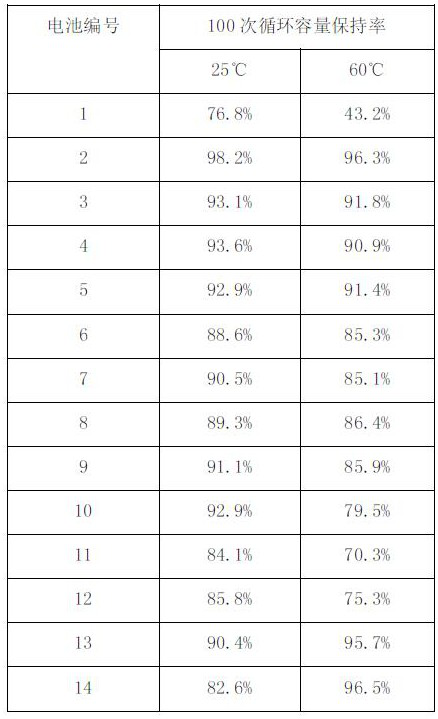Lithium battery electrolyte additive, electrolyte and lithium battery
An electrolyte additive, lithium battery technology, applied in the field of electrolyte and lithium battery, lithium battery electrolyte additive, can solve the problem of accelerating the anolyte decomposition of lithium dendrite growth, affecting the cycle life and safety performance of lithium ion batteries, and the ease of use of batteries. Problems such as bulging and flatulence occur, and the effects of increasing solid content, good hygroscopicity and improving circulation capacity are achieved.
- Summary
- Abstract
- Description
- Claims
- Application Information
AI Technical Summary
Problems solved by technology
Method used
Image
Examples
Embodiment 1
[0033] Preparation of lithium battery electrolyte additives: (1) Mix urethane acrylate and acrylic acid monomers at a mass ratio of 1:1; (2) Add 5% paraffin and 2% diatomaceous earth to the mixture in step (1) Mix well; (3) Add 2,2-dimethoxy-2-phenylacetophenone (3% of the total mass of urethane acrylate and acrylic acid monomer) and graphite powder to the mixture obtained in step (2) 0.1%, mix uniformly and then granulate; (4) Add 1% of the lithium halide-diatomite-graphite mixture to the product obtained after step (3) and mix uniformly (to make the lithium halide-diatomite-graphite mixture adhere to on the surface of the particles); (5) cured under ultraviolet light to obtain the lithium battery electrolyte additive.
[0034] Among them: (1) The amount of each raw material mentioned above is calculated based on the total mass of urethane acrylate and acrylic acid monomer;
[0035] (2) The above steps (1)-(4) are all carried out under dark conditions, and steps (3)-(4) shou...
Embodiment 2
[0038] Preparation of lithium battery electrolyte additives: (1) Mix polyurethane acrylate and acrylic acid monomers at a mass ratio of 1:1; (2) Add 3% paraffin and 0.5% diatomaceous earth to the mixture in step (1) Mix well; (3) Add 2,2-dimethoxy-2-phenylacetophenone (4% of the total mass of polyurethane acrylate and acrylic acid monomer) and graphite powder to the mixture obtained in step (2) 0.5%, mix uniformly and then granulate; (4) add 0.5% of lithium halide-diatomaceous earth-graphite mixture to the product obtained after step (3) and mix uniformly (to make lithium halide-diatomite-graphite mixture adhere to on the surface of the particles); (5) cured under ultraviolet light to obtain the lithium battery electrolyte additive.
[0039] Among them: (1) The amount of each raw material mentioned above is calculated based on the total mass of urethane acrylate and acrylic acid monomer;
[0040] (2) The above steps (1)-(4) are all carried out under dark conditions, and steps...
Embodiment 3
[0043]Preparation of lithium battery electrolyte additives: (1) Mix polyurethane acrylate and acrylic acid monomers at a mass ratio of 1:1; (2) Add 8% paraffin and 1.5% diatomaceous earth to the mixture in step (1) Mix well; (3) Add 2,2-dimethoxy-2-phenylacetophenone (5% of the total mass of polyurethane acrylate and acrylic acid monomer) and graphite powder to the mixture obtained from step (2) 0.2%, mix uniformly and then granulate; (4) Add 1.5% of the lithium halide-diatomite-graphite mixture to the product obtained after step (3) and mix uniformly (to make the lithium halide-diatomite-graphite mixture adhere to on the surface of the particles); (5) cured under ultraviolet light to obtain the lithium battery electrolyte additive.
[0044] Among them: (1) The amount of each raw material mentioned above is calculated based on the total mass of urethane acrylate and acrylic acid monomer;
[0045] (2) The above steps (1)-(4) are all carried out under dark conditions, and steps...
PUM
 Login to View More
Login to View More Abstract
Description
Claims
Application Information
 Login to View More
Login to View More - R&D
- Intellectual Property
- Life Sciences
- Materials
- Tech Scout
- Unparalleled Data Quality
- Higher Quality Content
- 60% Fewer Hallucinations
Browse by: Latest US Patents, China's latest patents, Technical Efficacy Thesaurus, Application Domain, Technology Topic, Popular Technical Reports.
© 2025 PatSnap. All rights reserved.Legal|Privacy policy|Modern Slavery Act Transparency Statement|Sitemap|About US| Contact US: help@patsnap.com

